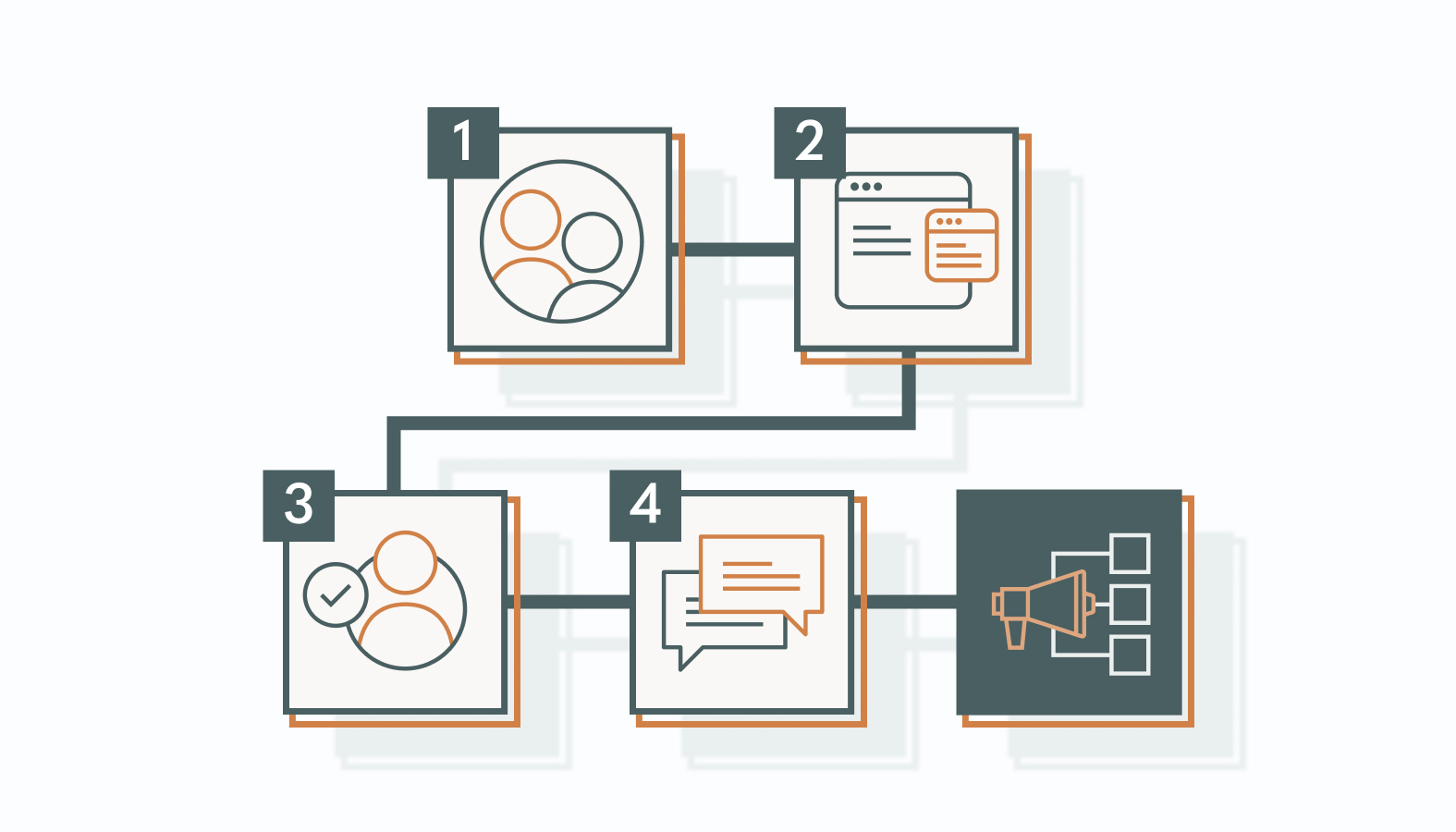Meet Sarah.
During her lunch break, she’s casually scrolling through Instagram when an ad for a sleek new pair of running shoes catches her eye. Curious, she taps the link, landing on the brand’s website. She browses for a bit but gets distracted and moves on without making a purchase.
Later that day, Sarah checks her email and sees a message from the same brand—personalized just for her. It highlights the shoes she was eyeing and sweetens the deal with a limited-time discount. This time, on her laptop, she clicks the link and completes her purchase.
That seamless journey—from discovery on social media to an email nudge and finally a sale—is multichannel marketing in action. It’s about meeting customers where they are, crafting a consistent and engaging experience, and turning interest into action.
Multichannel Marketing: The Basics
In today’s fragmented media landscape, brands that play it safe get left behind, while those that incorporate a multichannel strategy experience exponential growth.
At its core, multichannel marketing is about meeting your audience where they are—on social media, email, mobile apps, and even traditional channels. The goal is to craft a seamless, consistent brand experience that keeps customers engaged at every touchpoint.
Consumers bounce between platforms effortlessly; if your brand isn’t keeping up, you’re missing opportunities. The numbers don’t lie—businesses that embrace multichannel marketing see a 23% boost in customer satisfaction and an 89% retention rate (compared to just 33% for brands that fail to integrate their efforts).
The takeaway? Multichannel is a strategy and competitive edge. As digital ecosystems evolve, brands that master this approach will own the customer journey and drive real, measurable growth.
Advantages of Multichannel Marketing
Brands today can’t afford to rely on just one channel. Multichannel marketing makes it possible for big or small companies to amplify their reach, strengthen engagement, and drive serious business growth.
By strategically leveraging multiple platforms, brands create seamless, high-impact connections with their audience. The result? More visibility, deeper engagement, and a brand that stays top-of-mind.
1) Expand Audience Reach and Brand Visibility
Want to get in front of the right people and stay there? Multichannel marketing isn’t just about showing up—it’s about showing up everywhere that matters.
Powerhouse brands like Coca-Cola nail this by seamlessly integrating TV ads, social media buzz, and in-store experiences. The result? A brand presence that feels unavoidable (in the best way). When your message follows consumers across their favorite platforms, brand visibility skyrockets.
But here’s the kicker: channel selection makes or breaks your strategy. It’s not about being everywhere—it’s about being where your audience actually pays attention.
- A brand targeting millennials? Instagram and TikTok are your battlegrounds.
- Selling to C-suite execs? LinkedIn and email should be your power plays.
Winning in multichannel marketing means aligning your strategy with audience behavior—so every touchpoint is a step toward conversion.
2) Enhance Customer Interaction and Engagement
Customer engagement isn’t just about grabbing attention—it’s about creating meaningful interactions that drive loyalty. The best brands don’t just sell; they build communities through seamless multichannel experiences.
Take Starbucks—its mobile app isn’t just a payment tool; it’s a powerhouse for engagement. With personalized promotions, exclusive rewards, and a frictionless in-store experience, the brand keeps customers returning both online and offline.
Or look at Nike’s “Breaking2” campaign—a masterclass in multichannel storytelling. By combining live events, digital content, and social media buzz, Nike transformed a product launch into an emotional movement. The result? Deeper audience connection, explosive engagement, and unwavering brand loyalty.
The lesson is clear: Brands that integrate channels with purpose don’t just get noticed—they build lasting relationships that fuel long-term success.
3) Tailor Experiences to Meet Customer Preferences
In today’s crowded digital space, generic messaging won’t cut it. Customers expect brands to know their preferences, anticipate their needs, and deliver personalized experiences at every touchpoint. That’s where data-driven multichannel marketing comes in.
Take Amazon—a master of personalization. Amazon delivers hyper-relevant recommendations that keep customers engaged and drive conversions. The company does this by leveraging browsing history, purchase behavior, and predictive analytics.
To make personalization work, brands need the right tools. A well-integrated CRM system can track customer interactions across channels, providing a goldmine of insights to craft tailored campaigns that actually resonate. This results in more meaningful connections, higher engagement, and stronger brand loyalty.
4) Create Synergy Through Cross-Channel Integration
Consistency is currency. Customers interact with brands across multiple platforms—social media, email, mobile apps, physical stores—and they expect a seamless, unified experience at every touchpoint.
Cross-channel integration isn’t just about being everywhere. Instead, it’s about creating a cohesive brand narrative by maintaining a unified brand voice and leveraging marketing automation tools to synchronize campaigns across platforms.
Brands like Nike master this by ensuring every touchpoint—whether it’s an Instagram ad, an in-store experience, or an email campaign—feels like part of the same story. This level of integration builds trust, reinforces messaging, and maximizes engagement.
Multichannel marketing isn’t just about reach—it’s about impact. By strategically integrating platforms, brands can:
✔️ Expand their audience
✔️ Deepen customer engagement
✔️ Deliver hyper-personalized experiences
✔️ Create a strong, unified brand presence
The winning brands move beyond just “being present” on multiple channels and master the art of cross-channel synergy.
Overcoming Obstacles in Multichannel Marketing
Multichannel marketing comes with challenges that can limit success if not managed well.
From managing diverse platforms to ensuring accurate data interpretation, here’s how businesses can navigate these complexities and harness the full potential of multichannel marketing.
Simplifying Management and Coordination
Juggling multiple marketing channels and teams can get messy—fast. Each platform demands its own strategy, content, and timing, making campaigns easily disjointed and inefficient. When efforts aren’t aligned, messages get diluted, opportunities slip through the cracks, and resources get stretched thin.
Fortunately, once you know this challenge, you can address it with smart tools and automation. Platforms like Asana and Trello keep teams on the same page, ensuring seamless collaboration and streamlined workflows. A centralized marketing automation system takes it a step further, synchronizing campaigns across channels for consistent messaging and optimal timing.
The result is a campaign with a more significant impact and less chaos.
Decoding Marketing Attribution
Marketing attribution is a puzzle—your strategy suffers if you’re missing pieces. Understanding which channels drive conversions is critical, but misattribution can skew data, leading to wasted spend and missed opportunities.
To improve attribution accuracy, businesses can adopt multi-touch attribution models that track the entire customer journey, not just the final click. Tools like Google Analytics 4 and Adobe Analytics provide advanced insights, helping marketers allocate resources with precision and maximize ROI.
Using Data to Drive Results
In multichannel marketing, data isn’t just valuable—it’s everything. But harnessing it effectively is often where the challenge lies. Capturing, analyzing, and applying insights across platforms is the key to optimizing strategies and maximizing impact.
Businesses can enhance their data capabilities by employing Customer Data Platforms (CDPs) that unify data from every touchpoint, providing a single, clear view of your audience. Layer in AI-powered analytics, and you unlock predictive insights that take the guesswork out of decision-making—turning raw data into tangible results.
Staying Ahead with Innovation and Adaptation
In multichannel marketing, standing still isn’t an option. Consumer behavior shifts, technology evolves, and what worked yesterday might not work tomorrow. Brands that fail to innovate risk falling behind while competitors seize new opportunities.
To foster a culture of innovation, businesses should build a culture of agility. Encourage experimentation, embrace calculated risks, and equip teams with ongoing training on emerging trends and tools. Implement feedback loops and iterative processes to refine strategies in real-time.
Ultimately, success in multichannel marketing isn’t just about leveraging multiple platforms—it’s about evolving with them. Businesses can turn complexity into a competitive advantage by streamlining operations, sharpening attribution, harnessing data, and staying adaptive.
How to Develop a Multichannel Marketing Strategy
In a world where consumers seamlessly switch between devices and platforms, a scattered approach won’t cut it. A strong multichannel marketing strategy ensures your brand stays top-of-mind—wherever your audience is.
By intentionally engaging customers across multiple touchpoints, businesses can craft a seamless, connected experience that aligns with consumer behaviors.
The goal is to create a marketing ecosystem where every interaction—whether on social media, email, your website, or in-store—feels effortless and cohesive. Here’s how you can do this:
Encourage Team Collaboration
When marketing teams operate in silos, it’s easy for messaging to become inconsistent and opportunities to slip through the cracks. A unified approach across all channels is key to driving impact.
Collaboration ensures everyone—from social media to email marketing—works towards the same strategic vision. Tools like Slack or Microsoft Teams foster real-time communication, making it easier to stay aligned.
Additionally, scheduling regular cross-functional meetings and planning sessions builds a strong, collaborative culture. It ensures that every effort, regardless of channel, serves the broader brand goals.
Select the Best Platforms
Picking the right platforms is the cornerstone of a successful multichannel marketing strategy. It’s about casting a wide net and aligning your platforms with your business goals, audience preferences, and resources.
If you’re targeting younger customers, TikTok should be front and center, but a B2B brand could succeed more with LinkedIn and email marketing.
Platforms can be leveraged effectively by understanding their unique strengths. For example:
- Instagram shines with visually driven campaigns,
- LinkedIn is your go-to for building professional networks and establishing thought leadership.
Choosing the right mix ensures that your marketing efforts are practical and efficient, driving maximum return on investment.
Pinpoint and Segment Your Audience
Effective marketing starts with understanding your audience, which means digging into research and data analysis.
Audience segmentation is key to delivering personalized experiences that resonate, driving better engagement and conversions. You can craft messages that hit the mark by segmenting based on demographics, psychographics, and behavior.
With tools like data analytics platforms, businesses can uncover specific audience segments, tailoring content to match their unique needs and preferences.
Campaigns with proper audience segmentation create deeper, more meaningful connections that keep customers coming back.
Ensure Unified and Clear Messaging
Consistency is the bedrock of brand identity, and it’s essential that your message stays unified across all channels. When messages start to differ, it confuses customers and weakens the trust they place in your brand, leaving marketing efforts scattered and ineffective.
The key to developing cohesive content strategies is alignment:
- Ensure your communications reflect your brand’s voice and values at every touchpoint.
- A solid content calendar will keep messaging in sync, outlining themes and key points across platforms.
- Provide your team with clear guidelines and templates to ensure every piece of content feels cohesive and tailored to your audience.
This consistency will strengthen your brand’s identity, creating a smoother customer experience that reinforces trust.
Learn from Real-Life Marketing Success Stories
In the ever-evolving marketing world, real-life case studies are a goldmine for actionable insights. They show how strategies work in the real world, highlighting what drives success and how challenges are overcome. Dive into these stories, uncover practical tips that go beyond theory, and implement them to adapt and thrive.
How Maggi and Wagner Pizza Captured Their Market
Maggi and Wagner Pizza have mastered the art of multichannel marketing. Maggi tapped into TV commercials, social media, and in-store promotions to reach a broad audience, emphasizing convenience and taste to build brand loyalty, especially among busy families.
On the other hand, Wagner Pizza focused on digital ads, influencer collaborations, and engaging content to connect with consumers. By promoting quality and variety, Wagner stood out in a crowded market, boosting both market share and positive brand perception.
Both brands show the power of blending traditional and digital channels, demonstrating how tailored messaging can significantly boost engagement and visibility.
Gatwick Airport’s Strategy in Action
Gatwick Airport has successfully elevated customer experience through digital transformation and personalization. Their mobile one-stop-shop app, offering real-time flight updates, shopping deals, and tailored recommendations, has boosted passenger satisfaction and loyalty.
Using social media to provide travel tips and updates, Gatwick kept travelers informed and engaged, leading to better customer satisfaction and more frequent app usage.
Other businesses, particularly in travel and service industries, can adopt Gatwick’s approach by focusing on digital tools that enhance customer interaction. Prioritizing real-time information and personalized content can significantly improve the customer experience and encourage repeat business.
Insights from Agency’s Approach
At Agency, we believe in the power of data-driven strategies and personalized customer interactions. By tapping into comprehensive data analytics, we craft tailored marketing campaigns that blend digital and traditional marketing to resonate with specific audience segments. This precision targeting boosts engagement and conversion rates, making our approach highly effective across various industries.
Having spent years mastering the art of cross-channel campaigns, we know the importance of prioritizing data-driven personalization, integrating marketing efforts for seamless synergy, encouraging team collaboration, and leveraging the right technology to amplify results.
Learning from Success and Implementing Change
At Agency, we know that learning from the success of others is key to shaping a winning multichannel strategy. By reflecting on what’s worked in the past, businesses can craft a marketing approach that resonates with their audience and drives real results.
We’ve covered essential tactics like choosing the right platforms, personalizing interactions, and ensuring consistent messaging—now let’s break it down into actionable steps.
- First, strategic channel selection is crucial. You need to meet your audience where they spend their time, choosing platforms that match their preferences and behaviors.
- Then, consistency is everything. Messaging should be unified across every channel, reinforcing your brand identity and building trust.
- Personalization comes next—data-driven marketing is your secret weapon for tailoring messages and enhancing engagement.
- From there, integrate your efforts across platforms, creating a cohesive brand experience that flows seamlessly from one touchpoint to the next.
- And, of course, always stay agile—embracing new tools, technologies, and trends keeps you ahead of the curve.
Now, let’s get tactical. Start with thorough audience research—use surveys, social media listening, and analytics to inform your choices.
Keep your team in sync with tools like Trello or Slack, and ensure everyone’s aligned with project management. Use advanced analytics tools like Google Analytics or Adobe Analytics for accurate insights and attribution.
Encourage cross-functional collaboration—foster open communication and teamwork to break down silos.
Finally, create a content calendar to maintain consistency and ensure your messages always align with your brand’s goals.
By implementing these strategies, businesses can build a unified, engaging approach that boosts reach and drives lasting success. Embrace the power of multichannel marketing, and watch your brand grow.
Embracing the Power of Multichannel Marketing
Jumping into multichannel marketing is a game-changing opportunity to extend your brand’s reach and build stronger connections with your audience. With the strategies we’ve shared, you’re already on track to create a seamless and impactful marketing approach that resonates across platforms.
Curious about how these strategies can be tailored to fit your unique business? Or maybe you have a few questions about the best way forward. We’re here to help. Let’s discuss your marketing goals and explore how multichannel marketing can elevate your brand.
Schedule a candid conversation with one of our experts » and we’ll dive into your specific challenges and opportunities. No pressure, no strings—just an open conversation to help you succeed.








